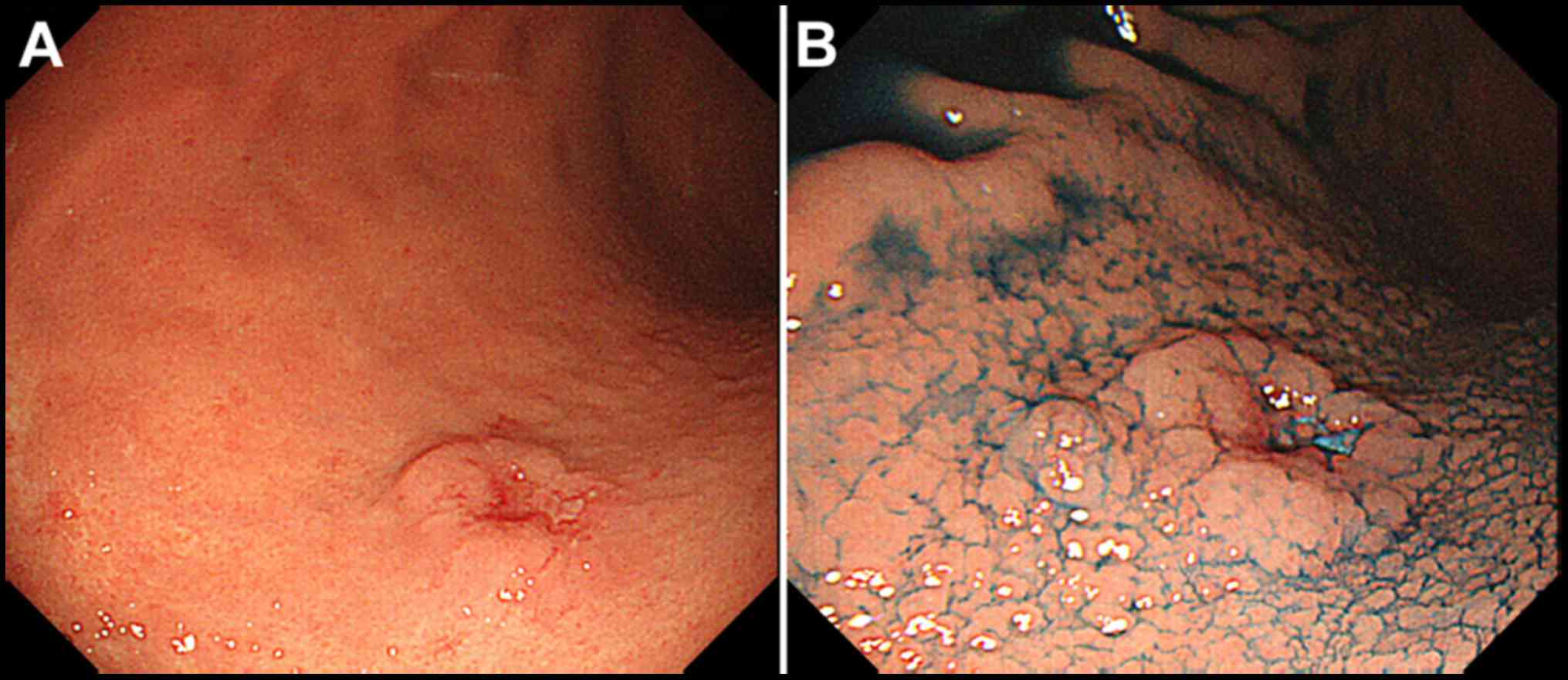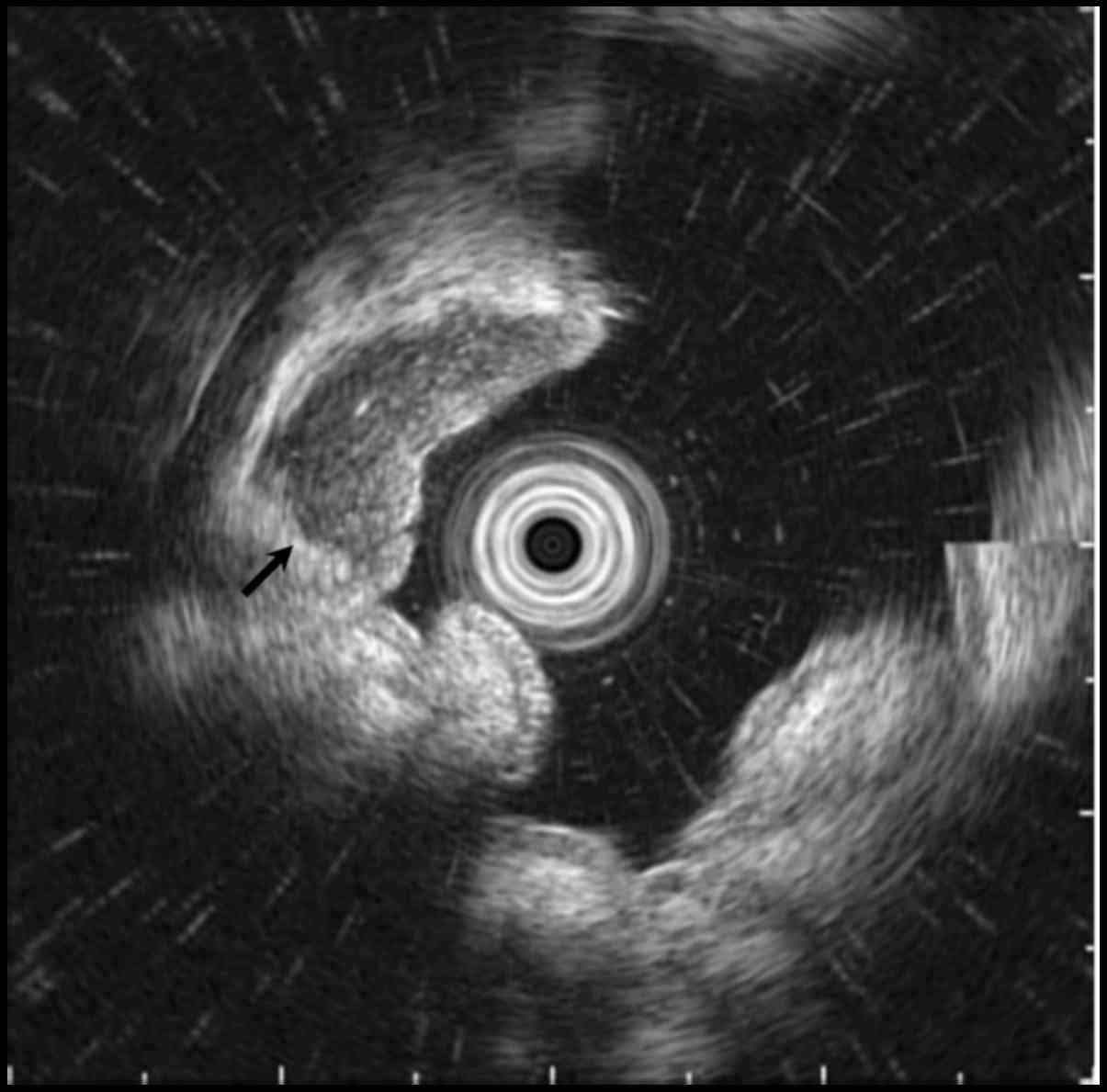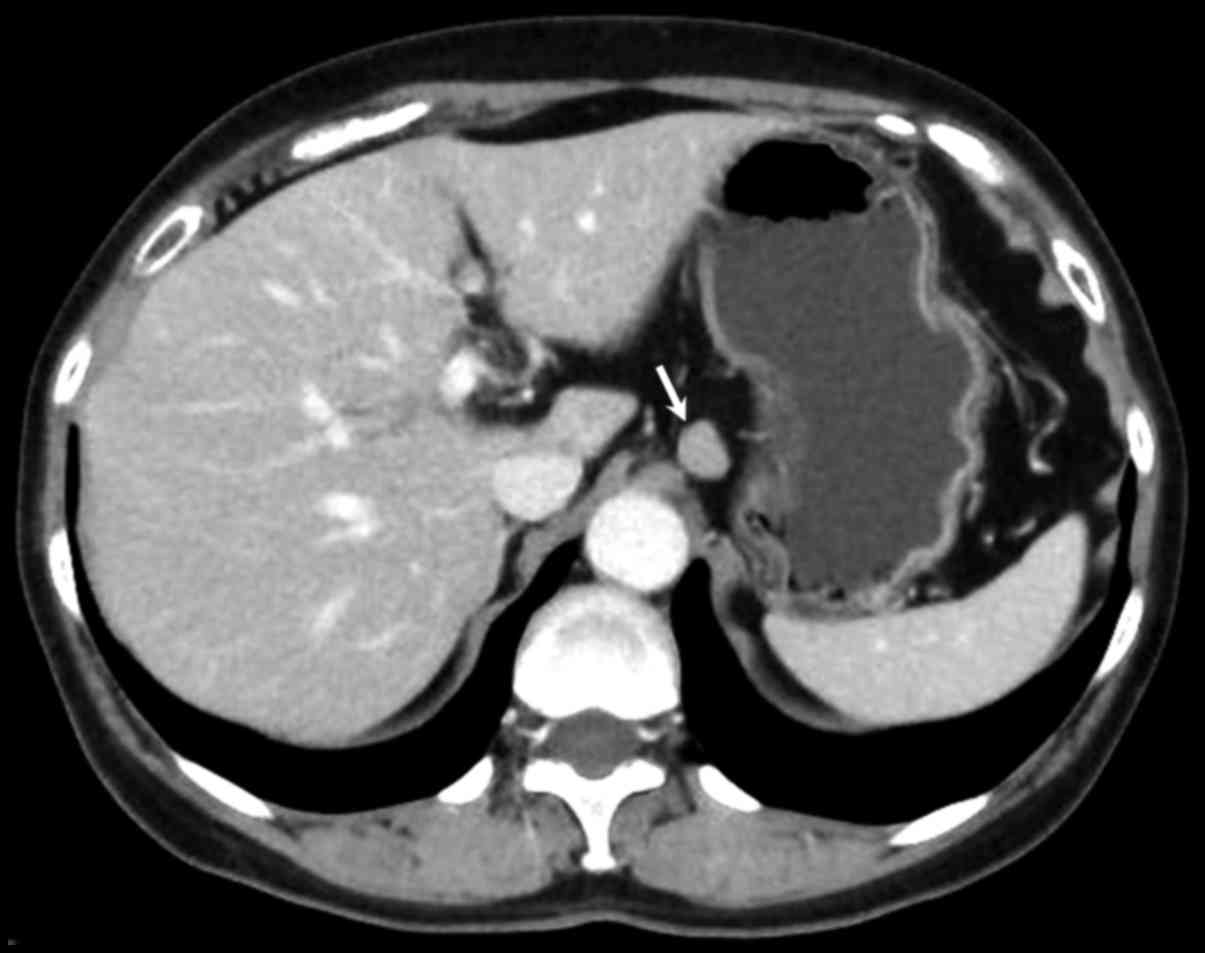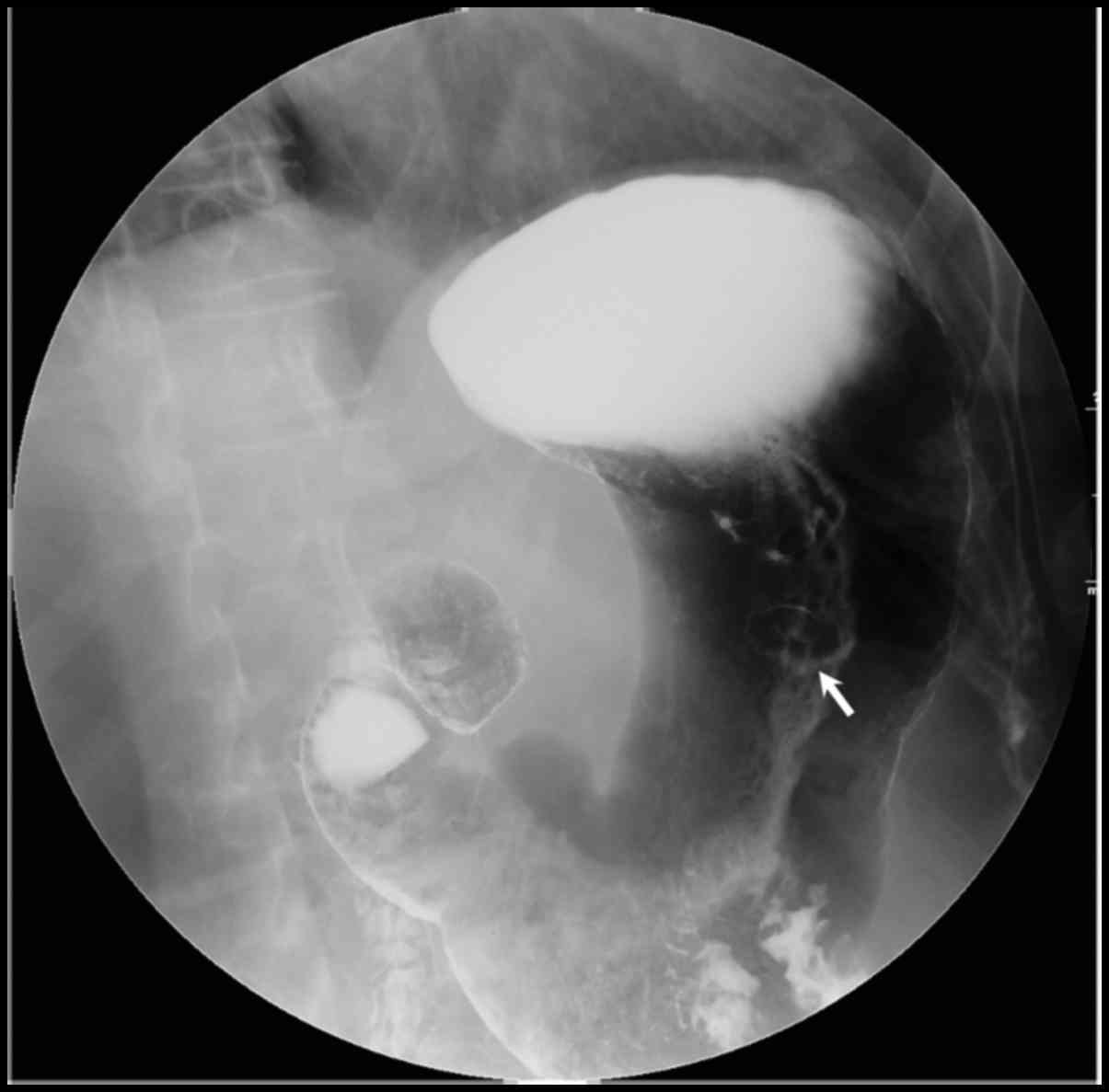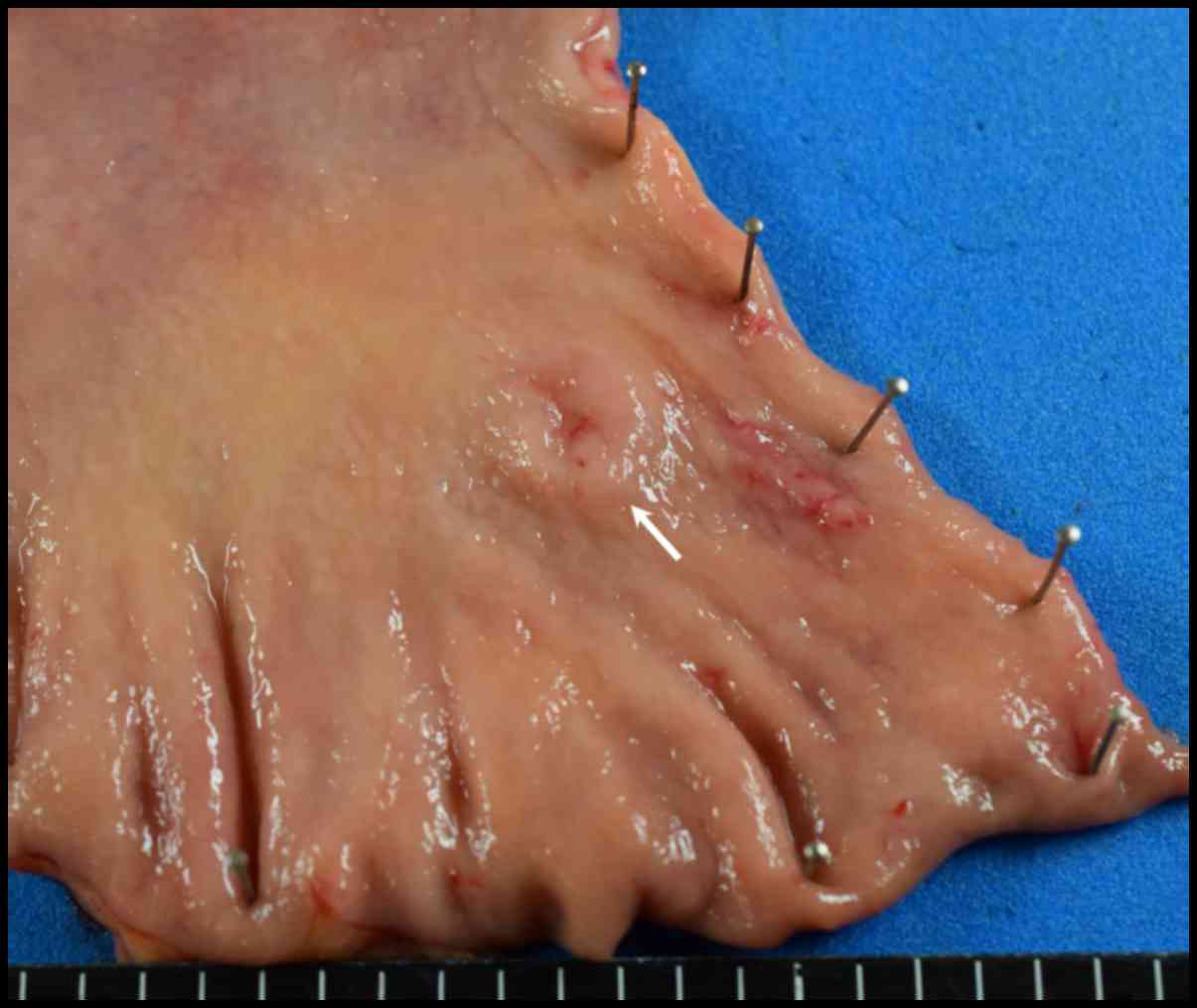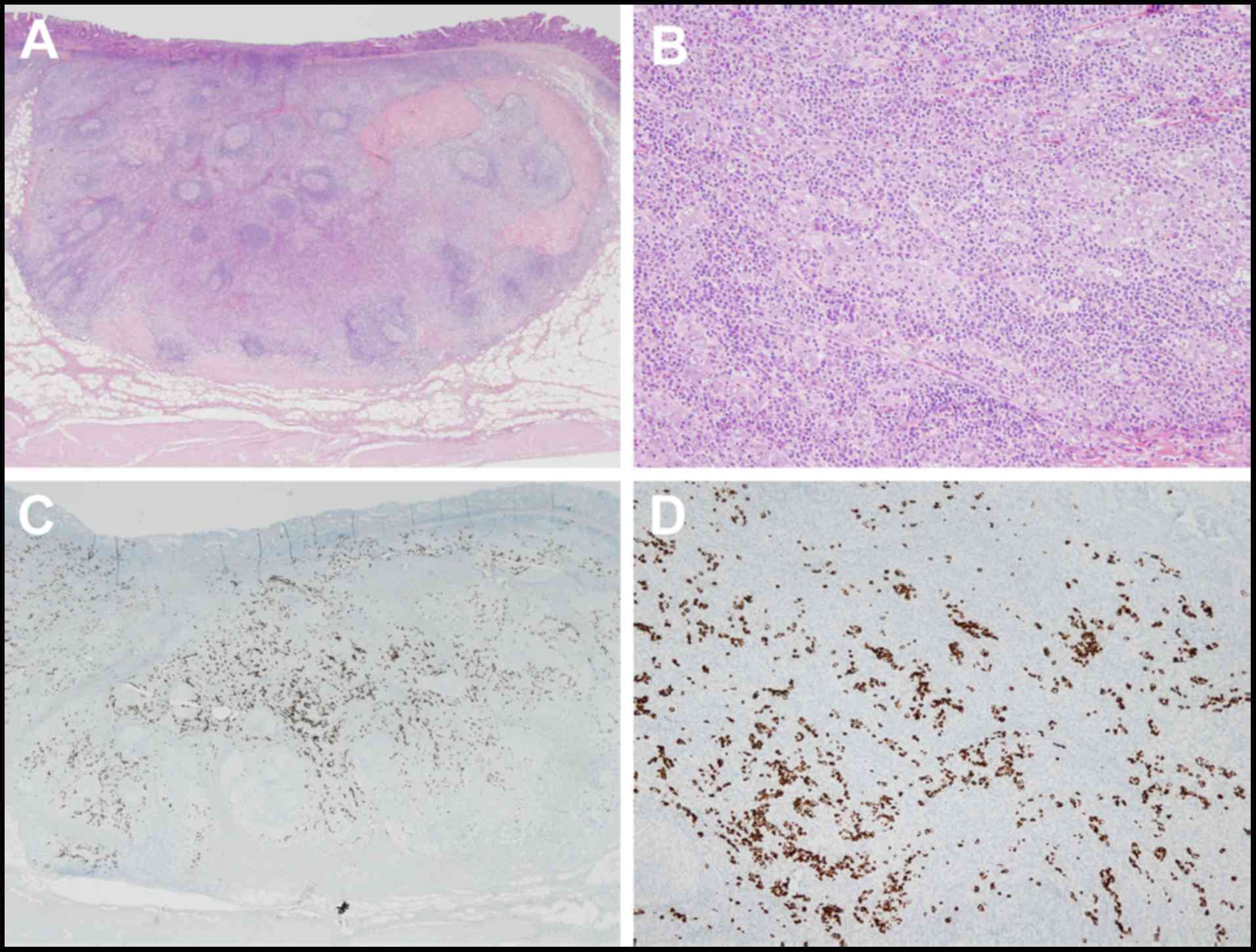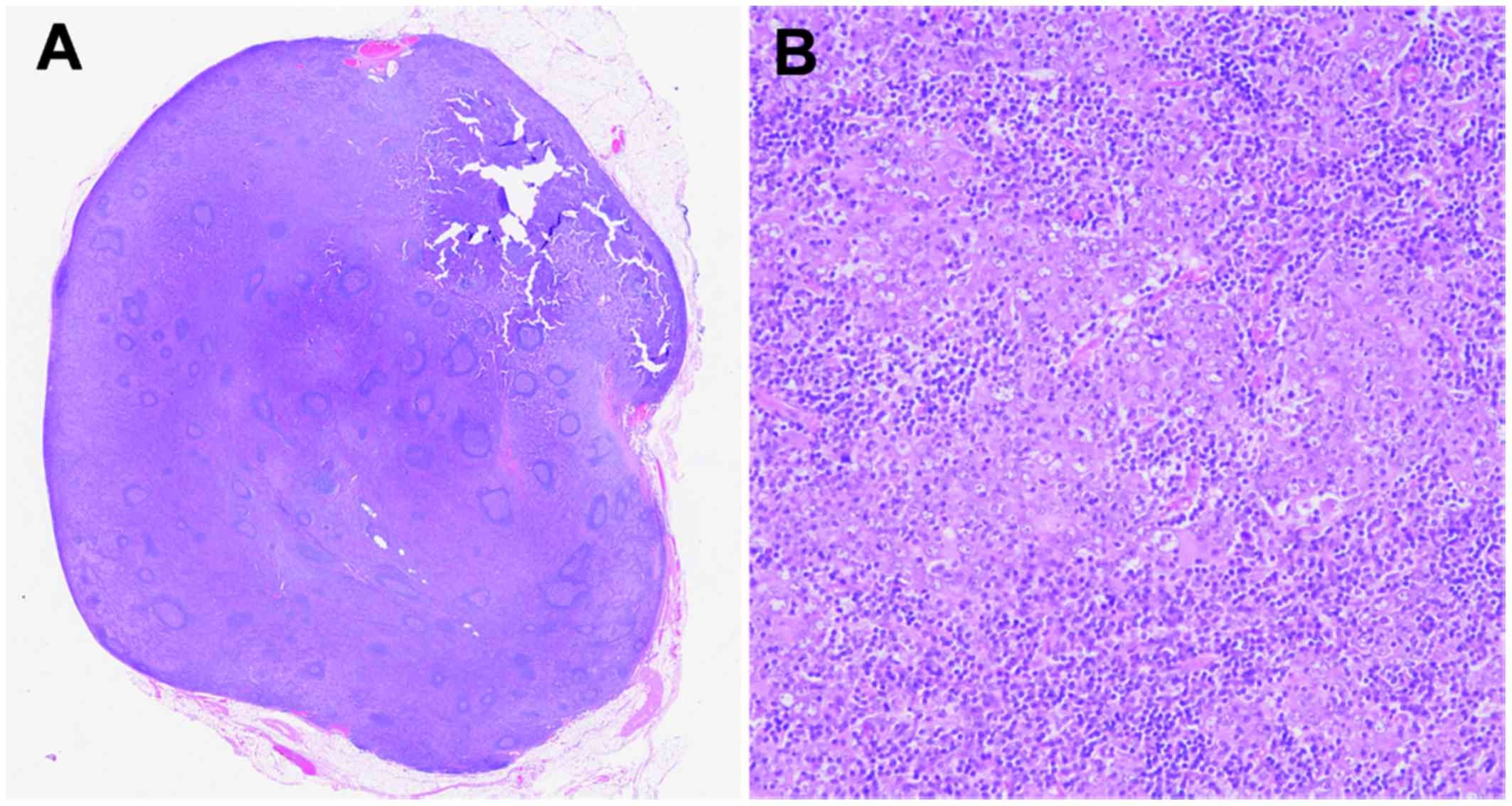Diagnostic usefulness of KL-6 concentration of bile in biliary tract cancer
- Authors:
- Published online on: February 12, 2018 https://doi.org/10.3892/mco.2018.1571
- Pages: 561-566
Abstract
Introduction
Epstein-Barr virus (EBV) is an established cause of various types of lymphoma including Burkitt lymphoma and Hodgkins lymphoma, and nasopharyngeal carcinoma (1). Similar to Helicobacter pylori, EBV is accepted as an infective agent that plays an important pathogenic role in gastric cancer (2,3). Gastric carcinoma with lymphoid stroma (GCLS) is a rare histological subgroup of gastric cancers, constituting approximately 1–4% of all gastric carcinomas. Approximately 80% of the reported GCLS cases are associated with an EBV infection (1,4). To diagnose GCLS accurately, the immunohistochemical approach of the tumor was important in addition to sophisticated observation of the endoscopic findings, while standardized diagnostic criteria are lacking (2,4). Early gastric cancer has favorable outcomes with curative resection including gastrectomy and endoscopic submucosal resection (4,5). The current prognosis for GCLS is favorable due to its lower lymph node metastatic rate and a higher survival rate despite deep submucosal invasion of tumor cells.
In the present study, we report a case of EBV-associated early GCLS accompanying lymph node metastasis treated by laparoscopic distal gastrectomy.
Case report
A 61-year-old woman was referred to Kochi Medical School Hospital as a result of an evaluation of a gastric mass lesion that was initially diagnosed by a local medical doctor. Laboratory investigations, including serum carcinoembryonic antigen and cancer antigen 19-9 screening showed no significant abnormalities. Esophagogastroduodenoscopy (EGD) revealed an elevated lesion with a central irregularly depressed area in the posterior wall of the middle third of the stomach (Fig. 1A). The elevated lesion descended in a gradual slope to the surrounding mucosa when indigo carmine dye was used in chromoendoscopy (Fig. 1B). Endoscopic ultrasonography (EUS) revealed a well-circumscribed hypoechoic mass located predominantly within the submucosa and the mucosa (Fig. 2, arrow). Biopsy specimens of the lesion showed prominent lymphocyte infiltration with a lymphoepithelial lesion, suspected of being carcinoma with lymphoid stroma.
Abdominal contrast-enhanced computed tomography (CT) revealed a well-defined mass with homogeneous enhancement approximately 1.2 cm in diameter in the middle part of the stomach. The CT analysis also revealed lymphadenopathy in the perigastric area with a maximum size of 1.4 cm in diameter (Fig. 3, arrow). Double-contrast upper gastrointestinal imaging shows a round filling defect with central collection of Barium measuring 1.2 cm with a clear margin in the middle part of the stomach (Fig. 4, arrow).
As a result of these investigations we suspected that the patient had a gastric carcinoma with lymphoid stroma accompanying lymph node metastases. The patient underwent laparoscopic distal gastrectomy with reginal lymphadenectomy followed by Billroth I reconstruction. Macroscopic examination of the resected specimen showed a slightly elevated lesion-like submucosal tumor with a central depression measuring 1.2×1.2 cm (Fig. 5, arrow).
Microscopic examination of the patient specimens showed a bulging mass consists of poorly differentiated adenocarcinoma. There was expansive growth into the submucosa that formed tubular structures and cancer nests with a submucosal depth of invasion of 4,000 µm (Fig. 6A and B). The tumor cells were positive for EBV-encoded RNA by in situ hybridization (EBER-ISH; Fig. 6C and D), and the expression of Ki-67 in cancer cells was 25%. In addition, there was one lymph node metastasis in 13 dissected lymph nodes, which was detected as lymphadenopathy in the CT imaging but there was no lymphovascular infiltration. The lymph node station number with metastasis was 3 according to anatomical definition of Japanese classification of gastric carcinoma (6), which was 2.0 cm in diameter, consisting of diffuse spreading of adenocarcinoma in the lymph node (Fig. 7A and B). The results of the other immunohistochemical investigations of the primary gastric cancer and metastatic lymph node showed positive immunostaining for cytokeratin (AE1/AE3) and negative for CDX-2. Marked infiltration of lymphoid cells was observed in the tumor stroma and these were negative for EBER-ISH. The postoperative course was uneventful and the patient has been well without evidence of recurrence for two months following the operation.
Discussion
GCLS has distinct clinical characteristics that occur in old age and predominantly in males. These tumors arise in the cardia or middle portion of the stomach and have prominent lymphocyte infiltration, particularly in the submucosa (7,8). EBER-ISH is the gold standard for determining EBV infection in histological sections. Carcinoma cells and dysplastic epithelial cells are positive for EBV, but not the normal epithelium or lymphoid stroma in EBV-associated GCLS. The estimate of EBV positivity in gastric cancer is 8.7% overall according to a meta-analysis, and the frequencies are not statistically different among different anatomical locations (1). Although EBV is considered to be the main cause of the lymphocytic response, the mechanism by which EBV contributes to the carcinogenesis of gastric mucosa has not been elucidated (9).
The rate of metastasis to the lymph node in submucosal cancers with GCLS is significantly lower than in conventional early gastric cancer, especially those involving an EBV infection (2,8). The spread of tumors through the gastric wall may be prevented by abundant lymphocytic reactions, which regulate the anti-tumor effect of immunity, resulting in a more favorable prognosis as a result of the immune response to the tumor (8,9). An investigation of 41 GCLS in early gastric cancer reported that there was no lymph node metastasis if the submucosal depth of invasion was ≤2,000 µm from the muscularis mucosa, while the incidence rate of lymph node metastasis was 28.6% if the SM depth of invasion was >2,000 µm (8).
Regarding the association between the sizes of gastric carcinoma and lymph node metastasis, Kim et al reported that there was no lymph node metastasis in the tumors with sizes <1.0 cm, and 2-dimensional tumor size was the only significant risk factor for lymph node metastasis in the analysis for 574 patients with differentiated minute submucosal cancer (10). Shin et al reported that tumor size was smaller in GCLS, 2.1 cm, than in no-GCLS, 3.1 cm, and only two patients with GCSL (3.4%) showed lymph node metastasis in the analysis of 1696 patients with early gastric cancer (11). Therefore, the lymph node metastasis of small size GCLS as the present case seems to be extremely rare.
In the present case, it was difficult to detect the submucosal invasion during EGD without EUS, because the majority of the lesion was a bulging mass with abundant lymphoid stroma that was located in the submucosa by pathological investigation. Standard radical gastrectomy with regional lymphadenectomy is important, recommending in cases with submucosal invasion of tumor cells to a depth of more than 2,000 µm, regardless of tumor size. EUS seems to be an essential modality to estimate the depth of tumor invasion in the diagnostic and therapeutic management of GCLS.
Since GCLS is a rare disease, clinicians should recognize the features of this entity to make an accurate diagnosis and select the appropriate treatment. Further studies and assessments of additional cases are required to establish standardized recommendation criteria and management for this entity.
References
|
Murphy G, Pfeiffer R, Camargo MC and Rabkin CS: Meta-analysis shows that prevalence of Epstein-Barr virus-positive gastric cancer differs based on sex and anatomic location. Gastroenterology. 137:824–833. 2009. View Article : Google Scholar : PubMed/NCBI | |
|
Liang Q, Yao X, Tang S, Zhang J, Yau TO, Li X, Tang CM, Kang W, Lung RW, Li JW, et al: Integrative identification of Epstein-Barr virus-associated mutations and epigenetic alterations in gastric cancer. Gastroenterology. 147:1350–1362.e4. 2014. View Article : Google Scholar : PubMed/NCBI | |
|
Lim H, Park YS, Lee JH, Son DH, Ahn JY, Choi KS, Kim DH, Choi KD, Song HJ, Lee GH, et al: Features of gastric carcinoma with lymphoid stroma associated with Epstein-Barr virus. Clin Gastroenterol Hepatol. 13:1738–1744.e2. 2015. View Article : Google Scholar : PubMed/NCBI | |
|
Watanabe H, Enjoji M and Imai T: Gastric carcinoma with lymphoid stroma. Its morphologic characteristics and prognostic correlations. Cancer. 38:232–243. 1976. View Article : Google Scholar : PubMed/NCBI | |
|
Namikawa T, Kitagawa H, Iwabu J, Okabayashi T, Sugimoto T, Kobayashi M and Hanazaki K: Clinicopathological properties of the superficial spreading type early gastric cancer. J Gastrointest Surg. 14:52–57. 2010. View Article : Google Scholar : PubMed/NCBI | |
|
Japanese Gastric Cancer Association, . Japanese classification of gastric carcinoma: III English edition. Gastric Cancer. 14:101–112. 2011. View Article : Google Scholar : PubMed/NCBI | |
|
Choi MG, Jeong JY, Kim KM, Bae JM, Noh JH, Sohn TS and Kim S: Clinical significance of gastritis cystica profunda and its association with Epstein-Barr virus in gastric cancer. Cancer. 118:5227–5233. 2012. View Article : Google Scholar : PubMed/NCBI | |
|
Huh CW, Jung DH, Kim H, Kim H, Youn YH, Park H, Kim JW, Choi SH, Noh SH and Kim JH: Clinicopathologic features of gastric carcinoma with lymphoid stroma in early gastric cancer. J Surg Oncol. 114:769–772. 2016. View Article : Google Scholar : PubMed/NCBI | |
|
Huang KH, Wang RF, Yang MH, Wu CW, Fang WL, Li AF, Chi CW and Kao HL: Advanced gastric cancer patients with lymphoid stroma have better survival than those without. J Surg Oncol. 107:523–528. 2013. View Article : Google Scholar : PubMed/NCBI | |
|
Kim TJ, Lee H, Min YW, Min BH, Lee JH, Kim KM, Kim MJ, Kim K, Rhee PL and Kim JJ: One-dimensional and 2-dimensional tumor size measurement for prediction of lymph node metastasis in differentiated early gastric cancer with minute submucosal invasion. Gastrointest Endosc. 85:730–736. 2017. View Article : Google Scholar : PubMed/NCBI | |
|
Shin DH, Kim GH, Lee BE, Lee JW, Ha DW, Jeon HK, Baek DH, Song GA, Ahn SJ and Park DY: Clinicopathologic features of early gastric carcinoma with lymphoid stroma and feasibility of endoscopic submucosal dissection. Surg Endosc. April 13–2017. View Article : Google Scholar : (Epub ahead of print). View Article : Google Scholar |



